Balcarres House
Balcarres House is just north of the village of Colinsburgh, in the East Neuk of Fife, eastern Scotland. It is based on a mansion built in 1595 by John Lindsay (1552–1598), second son of David, 9th Earl of Crawford. The house became the family seat of the Earl of Crawford. The present house is the result of substantial extensions in the early nineteenth century, using part of a fortune made in India, but preserves much of the original mansion.[1]
| Balcarres House | |
|---|---|
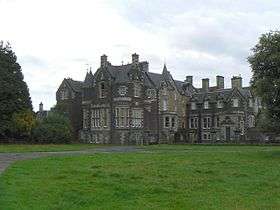 West façade of Balcarres House | |
| Coordinates | 56.2292°N 2.8499°W |
| Built | 1595 |
| Built for | John Lindsay of Balcarres |
| Architect | William Burn, David Bryce (19th century additions) |
| Owner | Robert, Earl of Crawford and Balcarres |
Listed Building – Category A | |
| Designated | 1 February 1972 |
| Reference no. | LB8625 |
| Official name: Balcarres | |
| Designated | 31 March 2005 |
| Reference no. | GDL00036 |
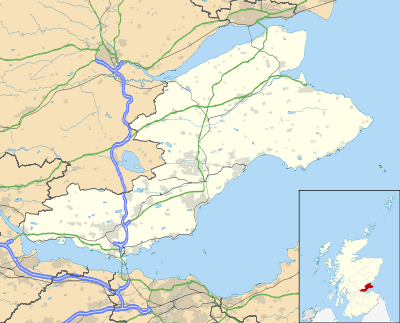 Location in Fife | |
Balcarres House is protected as a category A listed building,[2] and the grounds are included on the Inventory of Gardens and Designed Landscapes in Scotland, the national listing of significant gardens.[3]
Location
The house is on the southern slope of Fife, about 3 miles (4.8 km) from the coast. It commands a view of the Firth of Forth and Lothian on the opposite shore. On a clear day the towers of Edinburgh may be seen, 20 miles (32 km) away.[4]
History
The name Balcarres comes from the Gaelic baile carrach meaning rough or stony settlement.[5] The land on which Balcarres House stands was acquired by John Lindsay (1552–1598), second son of the 9th Earl of Crawford, in 1587. He also acquired other lands in Fife, which were erected into a barony in 1592.[3] He built the original mansion in 1595, three years before his death.[1] This original building was plain in design.[4] It comprised a Z-plan tower house, which itself incorporated an earlier turret.[2] This earlier tower had been built by Sir John Stirling of Keir around 1511.[3]
In 1633 King Charles I bestowed the title of "Lord Lindsay of Balcarres" on David Lindsay, second son of John Lindsay. David built a small Gothic chapel, and was buried there when he died in 1641. The chapel still stands near the road, but has lost its roof.[1] David's son Alexander was created Earl of Balcarres in 1651. He and his wife, Anna supported the Royalists through the Civil War,[6] dying in exile in Breda in 1659, while Balcarres was sequestered by the Parliamentarians. The Crawfords continued to back the Stuarts, and in 1689 Colin, 3rd Earl of Balcarres, was imprisoned and later exiled as a supporter of the deposed James VII. He was permitted to return to Scotland in 1700, but took part in the failed Jacobite Rising of 1715, and was subsequently placed under house-arrest at Balcarres. He later founded the estate village of Colinsburgh to the south of the house, before his death in 1722.[3]
In 1789 the sixth Earl Alexander, sold Balcarres to his brother, Robert Lindsay, who had acquired a fortune in India. Robert's son Colonel James Lindsay inherited the house in 1836. He commissioned a substantial extension to Balcarres from the architect William Burn, preserving most of the old house within it.[2] His son, Sir Coutts Lindsay, built another extension to the north east, and the terraced gardens, to designs by David Bryce in the 1860s.[2][7] In April 1886 Sir Coutts sold the estate to his nephew, James Ludovic Lindsay, the ninth Earl of Balcarres and twenty-sixth Earl of Crawford. It remains in the Earl's family.
Estate
To the east of the house there is a crag on which stands a folly. John Blackadder preached at a conventicle on this crag during the 17th-century persecution of the Covenanters.[1] The folly was built around 1820, and comprises a Gothic tower surrounded by mock ruins.[8]
The 17th-century chapel is protected as a scheduled monument.[9] The 17th-century sundial, brought here from Leuchars Castle is also listed at category A.[10] A late 17th or early 18th century dower house also stands in the grounds.[2]
The estate is represented by East Neuk Estates, a joint venture of six local landed families who continue to live on and run their estates, some of which date back to the Medieval era and are still largely agricultural. The other estates are Balcaskie (Anstruther family), Elie House (Nairn baronets), Gilston Estate (Baxter family), Kilconquhar Estate (Lindesay-Bethune family) and Strathtyrum (Cheape family).
Gallery
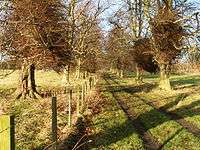 Woodland track heading towards Balcarres house from Colinsburgh.
Woodland track heading towards Balcarres house from Colinsburgh.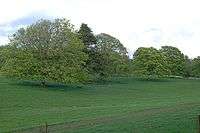 Near Balcarres: Mature trees and a section of the disused drive into Balcarres House
Near Balcarres: Mature trees and a section of the disused drive into Balcarres House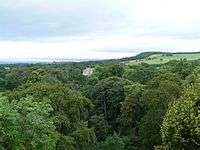 Balcarres House seen from the tower folly on top of Balcarres Craig
Balcarres House seen from the tower folly on top of Balcarres Craig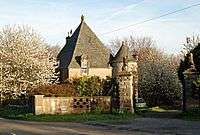 The Balniel gate house to Balcarres House
The Balniel gate house to Balcarres House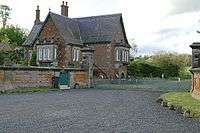 Balcarres Gatehouse, just east of the village
Balcarres Gatehouse, just east of the village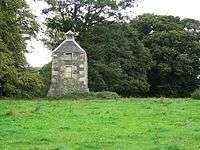 A substantial doocot in the grounds of Balcarres House
A substantial doocot in the grounds of Balcarres House
References
- Fleming 1886.
- Historic Environment Scotland. "BALCARRES HOUSE, INCLUDING OUTBUILDINGS DOWER HOUSE AND FRONT ENTRANCE GATES (Category A) (LB8625)". Retrieved 5 March 2019.
- Historic Environment Scotland. "BALCARRES (GDL00036)". Retrieved 5 March 2019.
- Chambers & Chambers 1844, p. 297.
- Liddall, W. (1896). The Place Names of Fife and Kinross. Edinburgh: William Green & Sons. p. 4. Retrieved 12 May 2015.
- Rosalind K. Marshall, ‘Mackenzie, Anna , countess of Balcarres and countess of Argyll (c.1621–1707)’, Oxford Dictionary of National Biography, Oxford University Press, 2004; online edn, Oct 2006 accessed 29 Nov 2014
- Historic Environment Scotland. "BALCARRES HOUSE TERRACED GARDENS (Category B) (LB8626)". Retrieved 5 March 2019.
- Historic Environment Scotland. "BALCARRES HOUSE - FOLLY ON BALCARRES CRAIG (Category B) (LB8630)". Retrieved 5 March 2019.
- Historic Environment Scotland. "Balcarres Chapel (SM826)". Retrieved 5 March 2019.
- Historic Environment Scotland. "BALCARRES HOUSE – SUNDIAL (Category A) (LB8627)". Retrieved 5 March 2019.
Sources
- Chambers, William; Chambers, Robert (1844). "A Pilgrimage to Balcarres". Chambers's Journal. Orr and Smith (610).CS1 maint: ref=harv (link)
- Fleming, D Hay (1886). "Kilconquhar". Guide to the East Neuk of Fife. Retrieved 12 February 2012.CS1 maint: ref=harv (link)